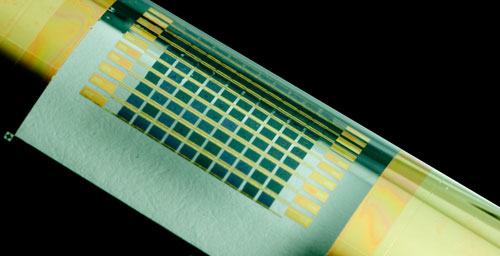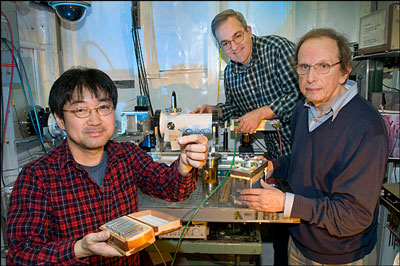Researchers at the J. Craig Venter Institute made the much-anticipated announcement today that they have created a replicating 'synthetic cell' - a bacterium with its DNA replaced by a 100% prosthetic genome. Eight leading synthetic-biology pundits reflect on what effect Craig Venter's latest achievement could have on science and society.
May 20th, 2010
Read more
 Thanks to a new semiconductor manufacturing method pioneered at the University of Illinois, the future of solar energy just got brighter.
Thanks to a new semiconductor manufacturing method pioneered at the University of Illinois, the future of solar energy just got brighter.
May 20th, 2010
Read more
 he newly patented catalysts, as well as a method for making a particular type of catalyst with a thin layer of platinum, could greatly reduce the cost and increase the use of fuel cells in electric vehicles. The catalysts and the technique are available for licensing.
he newly patented catalysts, as well as a method for making a particular type of catalyst with a thin layer of platinum, could greatly reduce the cost and increase the use of fuel cells in electric vehicles. The catalysts and the technique are available for licensing.
May 20th, 2010
Read more
After four years of fine-tuning an effective physical model and massive use of the supercomputer Mare Nostrum, researchers at IRB Barcelona and the Barcelona Supercomputing Center (BSC) have managed to produce the first realistic simulation of DNA opening at high resolution.
May 20th, 2010
Read more
An AFM system has been used to reveal the nanostructure and mechanics of mummified type I collagen from the 5300-year-old Tyrolean Iceman.
May 20th, 2010
Read more
Wissenschaftler im Forschungszentrum Dresden-Rossendorf haben einen Weg gefunden, das wenig effektive, amorphe oder nano-kristalline Silizium in Duennschicht-Solarzellen durch einen Nano-Schwamm aus Silizium zu ersetzen.
May 20th, 2010
Read more
Light-driven molecular switches are already used in technical devices such as LCD displays and storage media. Full comprehension of the processes at a molecular scale is required to increase their efficiency, but this knowledge had not been available to date.
May 20th, 2010
Read more
Researchers have succeeded in producing gel electrolytes for use in a light-control glass device using nanoparticles of Prussian blue-type complexes. The light-control glass device is based on the electrochromism phenomenon, and its color can be controlled between blue and transparent states by application of an electric current.
May 20th, 2010
Read more
The second issue of Nanotech Insights, a quarterly newsletter dedicated to the field of nanoscience and nanotechnology, is now available from CKMNT.
May 20th, 2010
Read more
Events will collectively draw more than 1,000 of the world's leading scientists, researchers and engineers to CNSE's Albany NanoTech Complex.
May 19th, 2010
Read more
A new study is using Nuclear Magnetic Resonance to move drug design into groundbreaking consideration of the dynamic flexibility of drugs and their targets.
May 19th, 2010
Read more
Sequencing DNA could get a lot faster and cheaper - and thus closer to routine use in clinical diagnostics - thanks to a new method developed by a research team based at Boston University.
May 19th, 2010
Read more
Neuroengineering is a rapidly growing discipline that takes its lymph from the increasing cross-fertilization of many areas of technology and science. By means of neuroengineering, advances in diverse technologies and in cellular and molecular biology converge into powerful tools to improve our understanding and treatment of neural (dis)functions.
May 19th, 2010
Read more
The workshop will look at the use of enabling technologies in nano-applications and will discuss areas where key technologies are yet to be established, with the aim to identify gaps in the market where UK companies can invest and become involved.
May 19th, 2010
Read more
Scientists are reporting development and successful testing of a sensor that can instantly tell whether someone has Type I diabetes.
May 19th, 2010
Read more
Four new projects, announced today, will develop biological methods that offer a new approach to antibiotic production, power generation for extremely small mechanical components, new classes of medicines and innovative techniques to study cell biology.
May 19th, 2010
Read more



 Subscribe to our Nanotechnology News feed
Subscribe to our Nanotechnology News feed